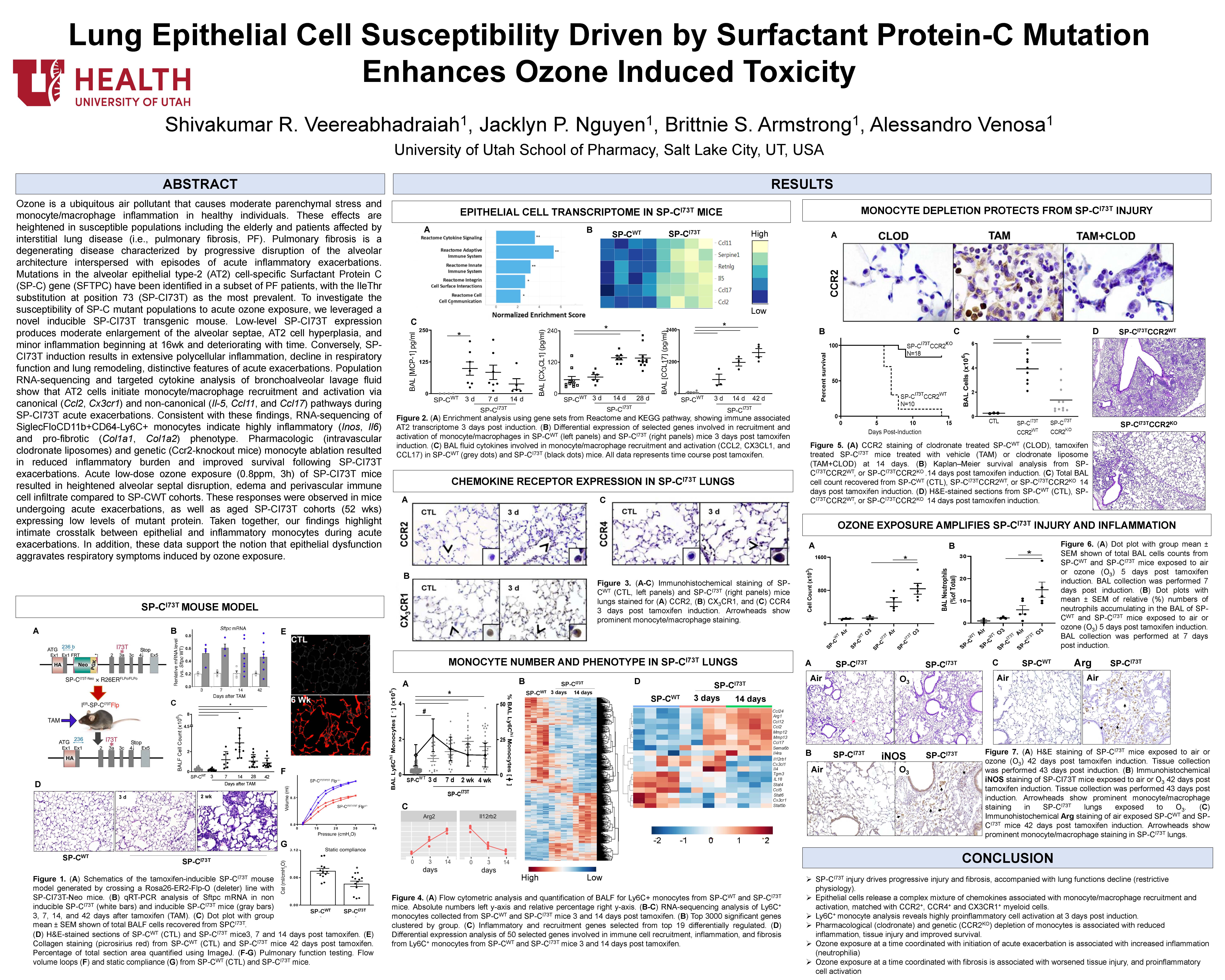
Global Health Symposium Poster Session
The posters and abstracts for the University of Utah 3i Initiative Global Health Symposium are listed below. Live Q&A will be from 3:10 - 4:00 PM MT on November 11th.
Poster Presentations:
- Sharia Ahmed - Machine Learning Identifies Key Risk Factors of Linear Growth Faltering and Death in Young Children With and Without Diarrhea
- Christiane Donkeu - Immunolocalization and functional characterization of PFE1445C: a novel integrin alpha-like cell adhesion protein in Plasmodium falciparum
- Noella Efange - Spirofused Tetrahydroisoquinoline-Oxindole Hybrids as a Novel Class of Antimalarial Agents with Multiple Modes of Action
- Dennis Fix - Immunomodulation using Macrophage Colony Stimulating Factor or Voluntary Wheel Running Rescues Aged Skeletal Muscle Function following Disuse Atrophy
- Balotin Fogang - IL-12p70, IL-8, IL-4 Cytokine responses but not antibody responses are associated with protection to clinical conversion of asymptomatic infections in highly exposed individuals in Cameroon
- Lisa Gibbs - Maternal Schistosomiasis Systemically Modulates Adaptive Immunity
- Anne Jensen - Wild-derived mice as a model for asymptomatic malaria
- Sanila Math - Himalayan Traditional Practices - Lessons from the Field
- Quinn Pritchett - Assessing Cytokine Profiles and Novel Coronavirus (COVID) Serology in Patients on Immunosuppression to Guide Care Recommendations
- Tejinder Singh, MDS,MPH - Buddhist Monks as Community Organizers: An Indigenous Response to COVID-19 in the Spiti Valley of Northern India
- Shivakumar R. Veerabhadraiah - Lung Epithelial Cell Susceptibility Driven by Surfactant Protein-C Mutation Enhances Ozone Induced Toxicity
Sharia Ahmed -
Machine Learning Identifies Key Risk Factors of Linear Growth Faltering and Death in Young Children With and Without Diarrhea
Benjamin Brintz, PhD Patricia B Pavlinac, PhD MS James A Platts-Mills, MD Karen L Kotloff, MD Daniel T Leung, MD Msc
Stunting affected 144 million children less than 5 years old in 2019, and contributed to 15% of all deaths. Identification of those at highest risk will enable new interventions and targeted approaches. We used clinical and demographic data from the Global Enteric Multicenter Study (GEMS) study to build predictive models of linear growth faltering (decrease of ≥0.5 or ≥1.0 in height-for-age z-score [HAZ] at 60 day follow-up) in children ≤59 months presenting with moderate-to-severe diarrhea (MSD), and community controls, in Africa and Asia. We screened variables using random forests, and assessed predictive performance with random forest regression and logistic regression using 5-fold cross-validation. We stratified by occurrence of MSD and by age categories. Of the 7332 cases and 11963 controls, average HAZ at enrollment was -1.3, and 1650 (22.5%) of cases and 1909 (16.0%) of controls experienced growth faltering (≥0.5 ΔHAZ), and 345 (4.7%) of cases and 384 (3.2%) of controls had ≥1.0 ΔHAZ. Baseline HAZ, wealth, mid-upper arm circumference, respiratory rate, temperature, and age were predictive of growth faltering, regardless of age group, diarrhea status, and ΔHAZ cutoff. Other top predictors in both cases and controls included number of people in the house and number of sleeping rooms. Unique predictors in MSD cases <12mo and controls were duration of diarrhea and height at enrollment, respectively. AUCs up to 0.77 were observed for ≥1.0 ΔHAZ, but predictive ability was lower (AUC 0.64) for ≥0.5 ΔHAZ. While growth faltering was higher in MSD patients, most risk factors were consistent among MSD sufferers and healthy community controls, regardless of the severity of growth faltering. Our model accurately identified children at high risk of growth faltering using clinical features, living conditions, and age. To better reveal probabilistic relationships between growth faltering and risk factors, Bayesian network models based on conditional dependence of variables will briefly be presented.
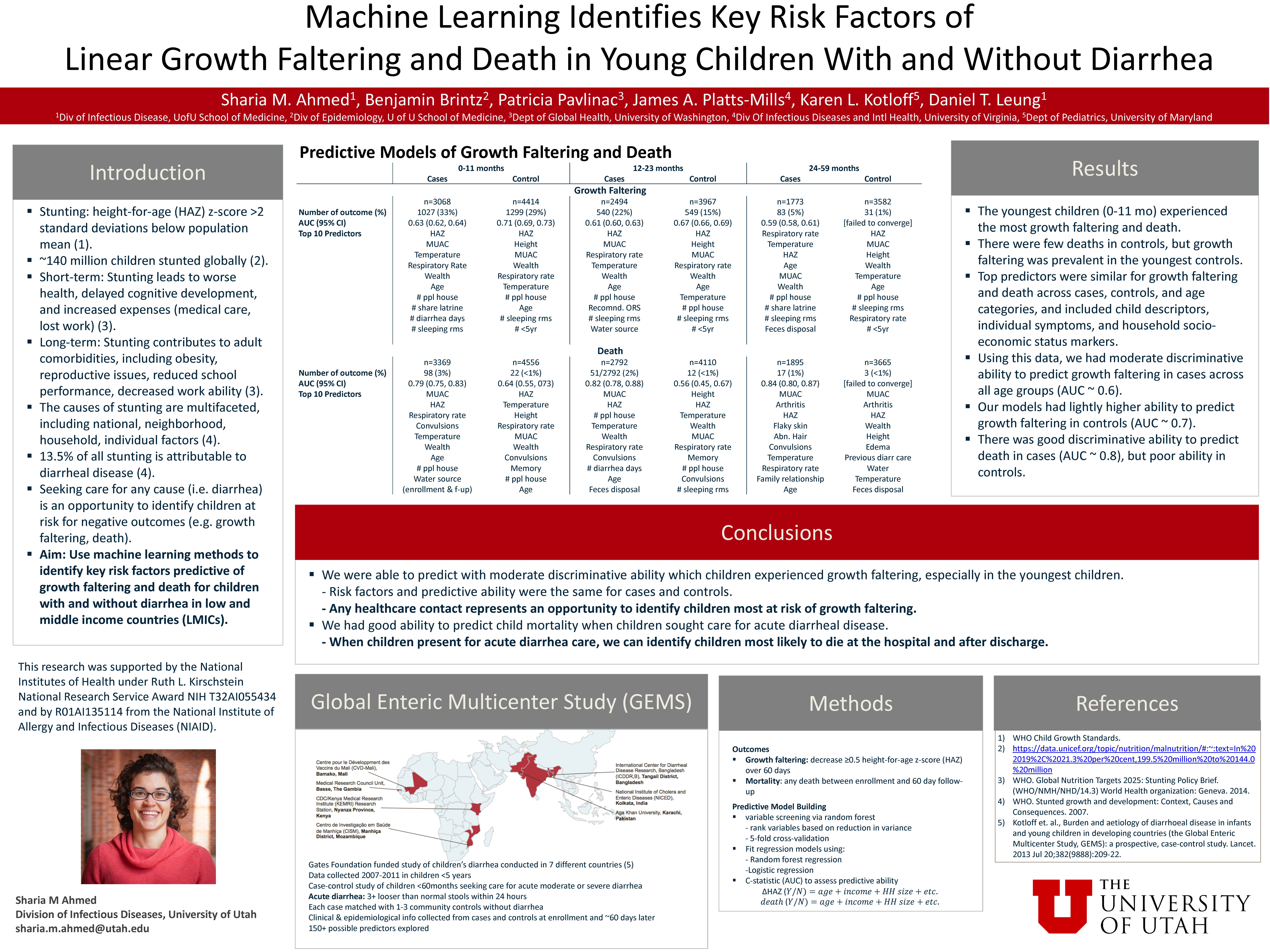
Christiane Donkeu -
Immunolocalization and functional characterization of PFE1445C: a novel integrin alpha-like cell adhesion protein in Plasmodium falciparum
Christiane Donkeu¹,², Rodrigue Keumoe¹,², Marie F. Biabi¹,³, Balotin Fogan¹,², Estelle Essangui¹,³, Sylvie Kemleu¹,⁴, Carole Eboumbou¹,³, Regis Grailhe⁵, Lawrence Ayong¹.
Background: Plasmodium cytoadherence is an important immune evasion strategy that ensures the development and expansion of malaria parasites in the human hosts. The cytoadherence/sequestration process of Plasmodium parasites is organ selective and thought to be mediated by a combination of specific ligands and receptors that are located in trans on both the parasite or infected erythrocyte surface membrane and the associated host cells. Whereas the cytoadherence protein, PfEMP-1 had been identified as the most important ligand for mature asexual stage parasite cytoadherence to microvasculature endothelia, the protein ligands responsible for sexual stage sequestration in collagen-rich bone marrow tissues have remained unknown. Here, we describe the initial characterization of a novel Plasmodium falciparum integrin-like protein with potential to mediate both asexual and sexual parasite sequestration in collagen-rich tissue linings. Methods: Plasmodium falciparum integrin-like proteins were identified by structural classification of proteins (SCOP) hierarchical search of integrin superfamily protein domains in malaria parasites. Polyclonal antibodies (anti-PfINT) reactive to the Plasmodium integrin alpha-like protein was elicited by immunization of rabbit with synthetic peptides derived from the membrane proximal extracellular domain of PFE1445C, and used in both Western immunoblot analysis and fluorescence microscopy examination of the protein in fixed cells. Protein function was further analyzed by investigating the effect of anti-PfINT on parasite growth in vitro as well as determining the association of anti-PfINT antibody carriage with protection against malaria. Results: Bioinformatics analysis of protein domains revealed a single protein in the Plasmodium falciparum 3D7 protein database with domain combinations consistent with those of classical integrin alpha proteins. No integrin beta tail domain proteins were observed using SCOP. Western blot analyses detected a single expected protein band at 82 kDa. This protein was predominantly expressed in Plasmodium trophozoites and schizonts where it appeared to localize to the developing merozoite surface. Anti-PfINT antibodies exhibited significant growth inhibitory effects against P. falciparum 3D7 culture, suggesting an effect on merozoite invasion in vitro. Anti-PfINT antibody levels were significantly high in sub-microscopically infected and asymptomatic endemic individuals compared to malaria patients, further indicating a role of anti-PfINT antibodies in natural protection against malaria. Conclusion: Taken together, our data suggest a role for PFE1445C in asexual development of P. falciparum parasites both in vitro and in vivo in humans. Our ongoing studies will define the role of PFE1445C in other pathogenic processes of malaria parasites. Keywords: Plasmodium falciparum; cell adhesion, integrin-like proteins.
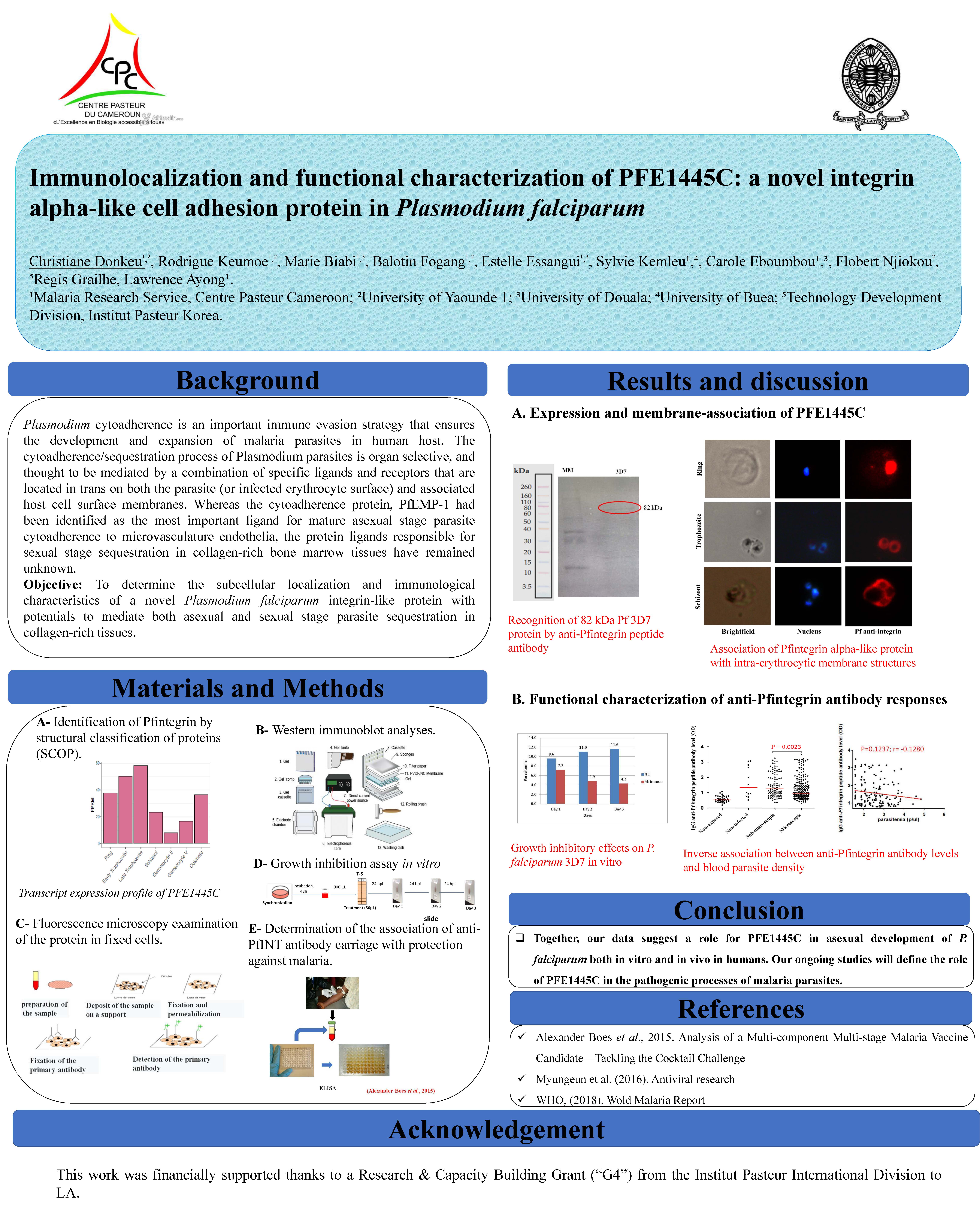
Noella Efange -
Spirofused Tetrahydroisoquinoline-Oxindole Hybrids as a Novel Class of Antimalarial Agents with Multiple Modes of Action
Maloba Lobe, Rodrigue Keumoe, Lawrence Ayong, Simon Efange
Molecular hybridization of privileged scaffolds may generate novel antiplasmodial chemotypes that display superior biological activity and delay drug resistance. We describe here the identification and mode of action characterization of a novel spirofused tetrahydroisoquinoline-oxindole hybrid designated (±)-moxiquindole with equipotent activities against chloroquine sensitive and multidrug resistant parasite strains. The racemate was active against all asexual stages of the parasite including inhibition of egress. Additionally, the compound exhibited significant inhibitory effect on hemoglobin degradation, and disrupted vacuolar lipid dynamics. Taken together, our data demonstrate the potential of spirofused tetrahydroisoquinoline-oxindoe hybrids as a novel class of multistage-active antimalarial compounds. Keywords: Plasmodium falciparum, Antimalarial agents, Privileged scaffolds, Molecular hybridization, Cellular mode of action
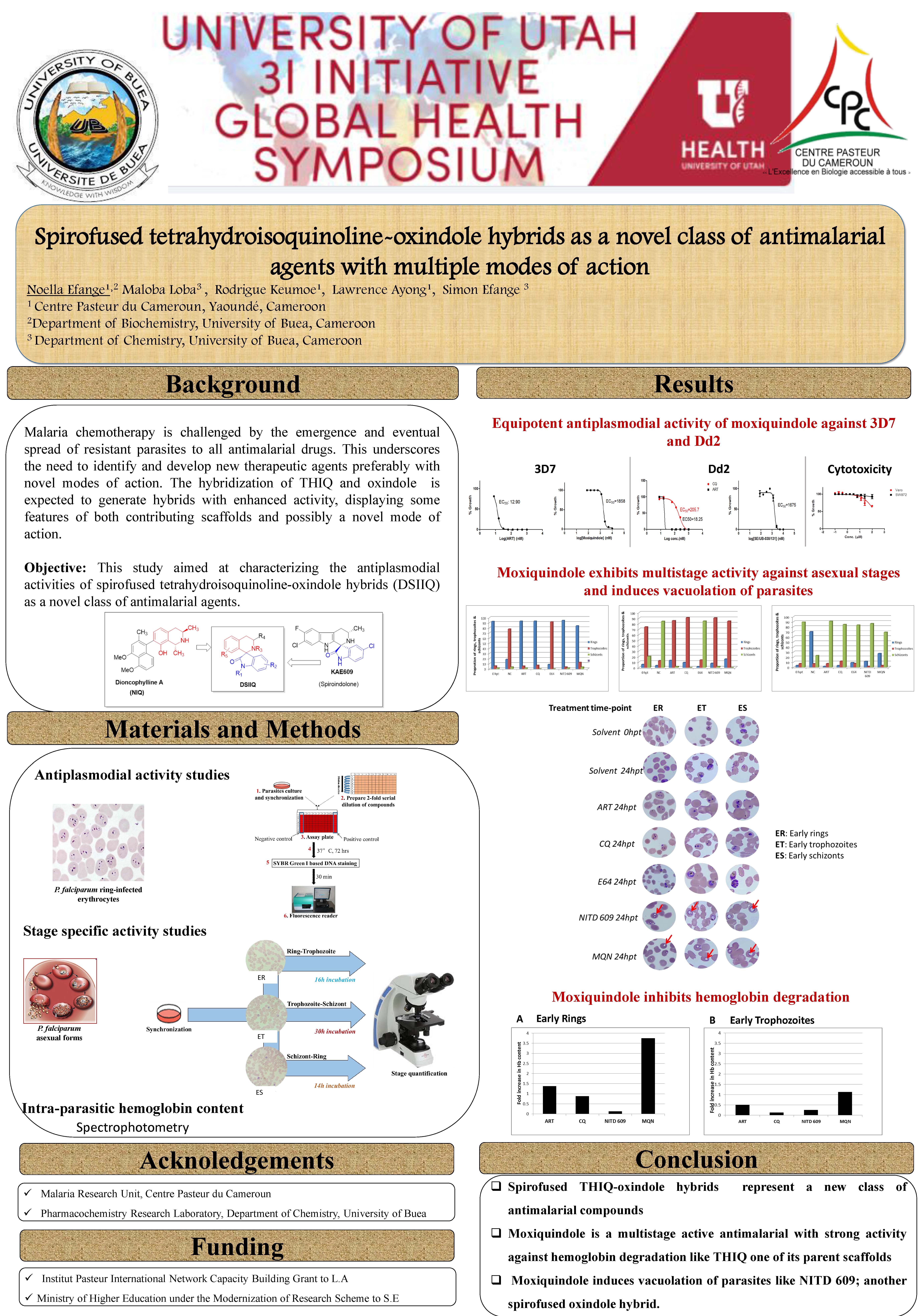
Dennis Fix, PhD -
Immunomodulation using Macrophage Colony Stimulating Factor or Voluntary Wheel Running Rescues Aged Skeletal Muscle Function following Disuse Atrophy
Paul T. Reidy, PhD, Jonathan J. Petrocelli, Alec M. Mckenzie, PhD, Ziad S. Mahmassani, PhD, and Micah J. Drummond, PhD.
Aging impairs muscle regrowth and function following a period of disuse. Poor recovery of muscle size and strength with aging coincides with a suppressed macrophage response and increased fibrosis. Immunomodulation in the form of exercise and cytokine injections has been demonstrated to improve skeletal muscle regeneration. However, it is unclear if these macrophage-promoting approaches would improve skeletal muscle recovery following disuse in aged animals. Therefore, the purpose of this study was to examine the effectiveness of macrophage colony stimulating factors (MCSF) or voluntary wheel running (VWR) on the recovery of muscle and strength following disuse atrophy in aged mice. Aged (20-22 mo) male C57BL/6 mice were assigned to be an ambulatory control, or undergo 14 days of hindlimb unloading or 14 days of hindlimb unloading followed 14 days of reloading. Mice in the recovery group received a single injection of MCSF or PBS in both triceps surae while a second group of recovery mice underwent 14 days of VWR. We found that MCSF and VWR at the initiation of reloading enhanced soleus muscle regrowth and rescued grip strength above ambulatory control and PBS injection. Moreover, following MCSF and VWR, soleus muscle cross sectional area and the ratio of BHP/COLIV (indicative of decreased fibrosis) was also elevated above control and PBS. Overall, these results suggest that immunomodulating approaches such as MCSF and VWR during the recovery phase from disuse atrophy restore aged skeletal muscle mass, myofiber size, and grip strength while also reducing muscle fibrosis.

Balotin Fogang -
IL-12p70, IL-8, IL-4 Cytokine responses but not antibody responses are associated with protection to clinical conversion of asymptomatic infections in highly exposed individuals in Cameroon
Mathieu Schoenhals, Franklin Maloba, Estelle Essangui, Christiane Donkeu, Marie Abite, Glwadys Cheteug, Marie Kapen, Rodrigue Keumoe, Sylvie Kemleu, Ronald Perraut, Rosette Megnekou, Tracey Lamb, Lawrence Ayong
Background: The asymptomatic carriage of malaria parasites, particularly for extended durations in areas with high transmission of P. falciparum represents a serious challenge to malaria elimination globally. Two keys immunological processes, including anti-parasite and anti-disease immunity have been implicated in establishment and maintenance of asymptomatic infections. However, the immunological factors that determine the conversion from asymptomatic infections to symptomatic malaria remain poorly understood. We sought to this study to determine the association between antibody or cytokine responses and clinical conversion of asymptomatic infections in highly exposed persons in Cameroon. Methods: Asymptomatic individuals were followed for 10 weeks, during which time some developed malaria-associated fever and others remained asymptomatic. Plasma levels of IgG antibodies to P. falciparum soluble extract (SE) and to recombinant proteins EBA-175, MSP-1c19 and MSP-4p20, and 38 cytokines were measured and compared between asymptomatic groups. Results: Of 142 asymptomatic individuals who completed the study, 68 (47.9%) developed malaria-associated fevers within 10 weeks of follow-up, representing a symptomatic conversion rate of 4.8% per week. No association was found between plasma antiplasmodial antibody levels or avidities and clinical conversion of asymptomatic infections, suggesting a non-essential role of antiplasmodial antibodies in protection against early clinical conversion. Circulating levels of the pro-inflammatory factors IL-12p70, IL-8, Flt-3L and TGF-α, as well as the Th2 regulatory cytokine IL-4, were significantly lower in individuals who convert to symptomatic malaria. Additionally, anti-inflammatory IL-10 to TNF-α, TNF-β, IFN-γ and IL-6 cytokine ratios were higher in converters, suggesting an IL-10 biased anti-inflammatory response in clinical conversion. Conclusion: Taken together, the above findings implicate cytokine but not antibody responses in clinical conversion during asymptomatic infections in highly exposed Cameroonians.
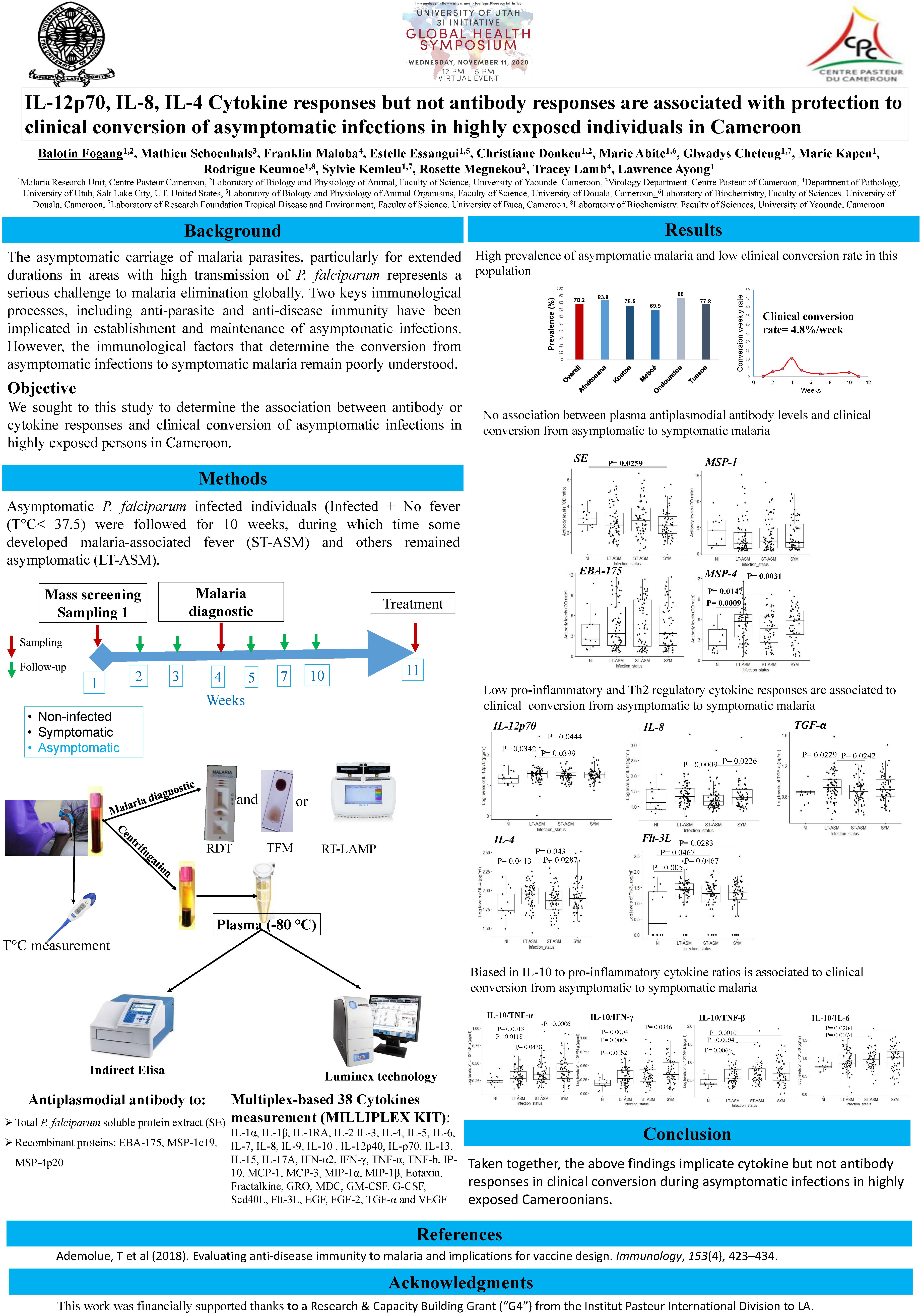
Lisa Gibbs -
Maternal Schistosomiasis Systemically Modulates Adaptive Immunity
Diana Cortes-Selva, Andrew Ready, H. Atakan Ekiz, Ryan M. O'Connell, Bartek Rajwa, Keke C. Fairfax
Maternal helminth infections are a global public health concern that correlate with altered infant immune responses to childhood immunizations. A mechanistic understanding of how maternal helminth infection alters the cellular immune responses of offspring is lacking, but is critical to improve childhood vaccine regimens in endemic areas and to understand the consequences of specific long-lived immunity defects. Children born to mothers infected with Schistosomiasis often have measurable Schistosome egg antigen (SEA) titers that correlate with maternal titers. Using our newly established model of model of maternal Schistosoma mansoni infection in dual IL-4 reporter mice, we find that murine pups born to mothers chronically infected with Schistosoma mansoni have anti-SEA titers that correlate with maternal titers, similar to what has been reported in human maternal infections. Additionally, offspring of infected mothers have reduced peripheral memory B and Th2 cells at steady state and following Tetanus/Diphtheria immunization. To determine the transcriptomic mechanism that may underlie this defect, we used a single cell sequencing approach on age matched pups born to chronically S. mansoni infected mothers, mothers infected with a single sex infection, and uninfected mothers. We have identified an egg-dependent pattern of transcriptional alterations to B and T cells that center on control of cell cycle and proliferation. We hypothesize that this transcriptional profile is the mechanistic root of long-lived defects in cellular immunity to foreign antigens.

Anne Jensen -
Wild-derived mice as a model for asymptomatic malaria
Anne M. Jensen, Douglas H. Cornwall, Adesola C. Olatunde, Mellina T. Srey, Franklin Maloba, Birk K. Evavold, Brian D. Evavold, Tracey J. Lamb
Individuals with asymptomatic malaria are a potential reservoir of disease transmission and pose a significant threat to the control of malaria worldwide. Asymptomatic malaria is usually defined as malaria without overt symptoms although mild anemia is often present and individuals tend to be more susceptible to bacterial co-infections. Asymptomatic malaria can occur at all ages. In older individuals asymptomatic malaria is thought to be associated with the development of the adaptive immune response after cumulative exposure to Plasmodium spp. However, in young children under the age of 2 asymptomatic malaria occurs prior to the development of robust adaptive immunity. In this age group we hypothesize that differences in the immune response controlled by genetic variation of the host determines the outcome of disease. There is currently no mouse model for asymptomatic malaria. Here we utilize a specific pathogen free (SPF) wild-derived Mus musculus domesticus mouse strain with a similar amount of genetic variation to that of humans to demonstrate genetic control of asymptomatic malaria. When infected with Plasmodium yoelii XNL wild-derived mice display a large variation of anemia ranging from asymptomatic to severe. To explore the immunological correlates of anemia severity, we determine splenic responses at the end of the infection period (day 19 post-infection) and saw that innate immune responses were significantly correlated with the severity of anemia. In general severity of anemia in symptomatic wild-derived mice were associated with a higher proinflammatory response compared to the asymptomatic wild mice. In particular TNF-, as expected, appeared to be involved in inducing anemia as might be expected from published studies. These findings suggest that using the wild-derived mice to model genetic diversity within human populations may enable us to pinpoint the immunological nature of the asymptomatic malaria.
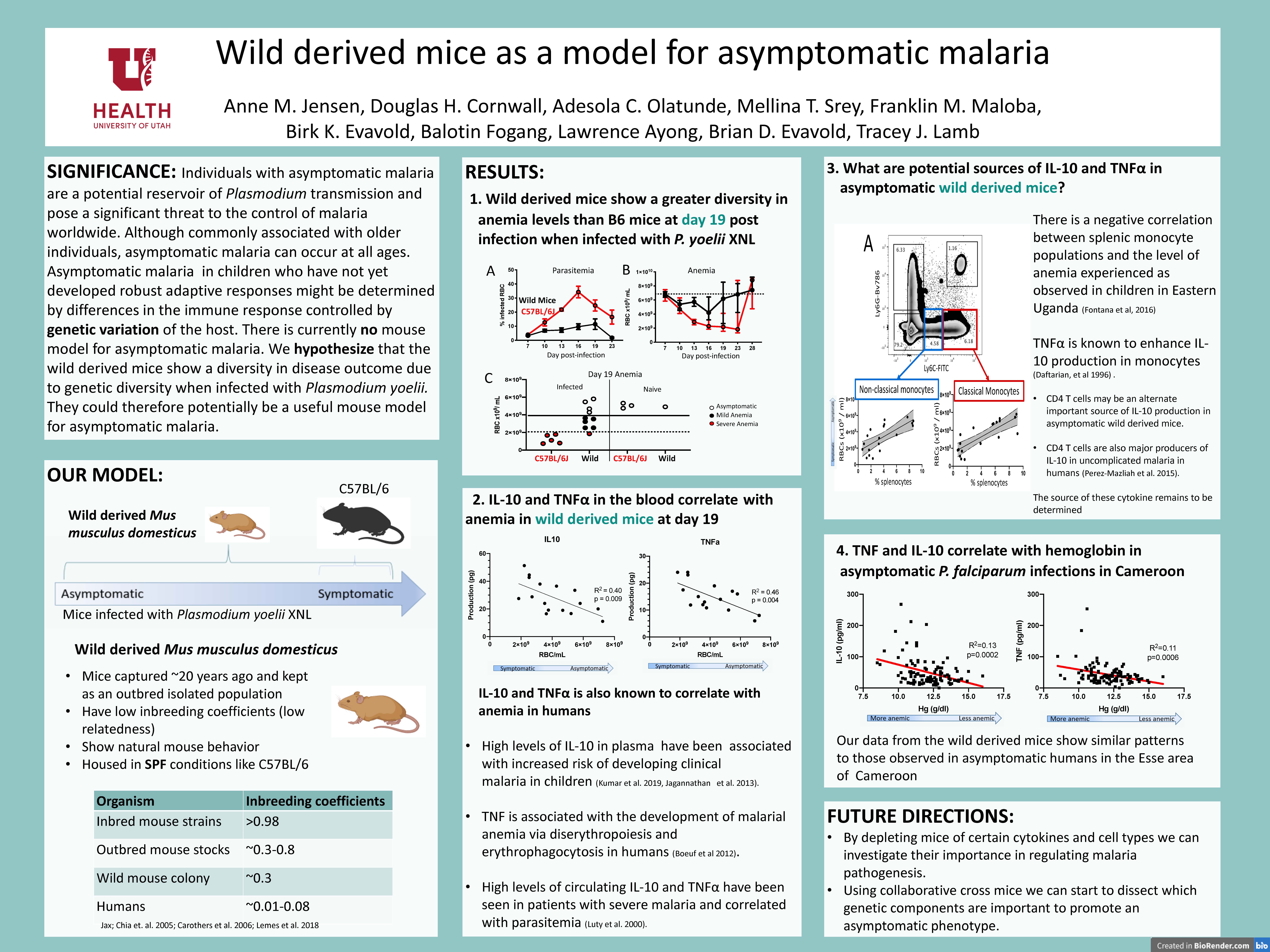
Sanila Math -
Himalayan Traditional Practices - Lessons from the Field
Title: Himalayan Traditional Practices - Lessons from the Field Background Sowa Rigpa, meaning “science of healing,” is commonly practiced in the Spiti Valley region of the Himalayas in India. It has recently gained official recognition as a form of traditional medicine in the country. The objective is to integrate it with the practice of conventional medicine as recommended by the World Health Organization. The expected outcome is a robust national health system advancing primary healthcare and universal health coverage. Currently, it is critical to understand utilization of Sowa Rigpa; when, why and how individuals approach its practitioners, the Amchis, mostly equipped with medical knowledge transmitted over six or more generations. This will also explain the intersection of Sowa Rigpa with conventional medicine. However very few explorations address this need. This study attempts to fill this gap.
Methods A cross-sectional study design with convenient sampling was used. 67 consenting adults from 5 villages of the Spiti Valley were interviewed using a modified and translated version of National Family Health Survey-4 questionnaire. Data was analyzed using STATA 14 (StataCorp).
Results Of the 67 individuals, ages 26-86 years (mean 55.88 years), 91% utilized Sowa Rigpa. Utilizers were more women (100%) then men (86%). Utilization was universal, irrespective of individuals’ marital status, occupation, socioeconomic status, literacy level and type of family. Significantly, acute illness and pain management were primary reasons for seeking this care over chronic disease (p< 0.05).
Conclusion Sowa Rigpa is widely utilized in Spiti Valley. Utilization is a ‘step-like’ structure where individuals visit the Amchi first before accessing a clinic or hospital. Optimal support to Sowa Rigpa can potentially lower burden of disease and improve quality of life. It has the credentials for an integrated, universal, respectful and culturally appropriate primary care in remote areas of Spiti Valley and elsewhere.

Quinn Pritchett -
Assessing Cytokine Profiles and Novel Coronavirus (COVID) Serology in Patients on Immunosuppression to Guide Care Recommendations
Rebecca Overbury, Dorota Lebiedz-Odrobina, Stacey L. Clardy, Julie Thomas, Tawnie J Braaten, Thomas B. Martins, Marc Elgort, Emily S. Spivak, Patricia Slev, Lisa K. Peterson, Tracy M. Frech
Objective: This study combined data from cytokine profiles and serological testing from autoimmune disease patients on immunomodulatory therapy obtained at the time of toxicity monitoring in order to inform guidelines for the treatment of high-risk populations during the 2019 novel coronavirus (COVID-19) pandemic.
Methods: 153 consented patients verified their autoimmune diagnosis, current immunosuppression medications, and whether they believed they currently or previously had symptoms of COVID-19. Previous COVID-19 PCR testing was confirmed. A 13-cytokine panel and COVID-19 IgG testing were performed on patient sera.
Results: 150 patients underwent a laboratory draw. The most common diagnosis was systemic sclerosis (49%) followed by rheumatoid arthritis (18%). Over half the patients (59%) were on hydroxychloroquine. Only one patient tested PCR positive for COVID-19 and that same patient was the single COVID IgG positive result in this cohort. No asymptomatic COVID IgG carriers were identified. There were cytokine elevations in 57 patients, with 17 patients having more than one cytokine elevation. The most common elevated cytokines were IL-10 in 24 (16%), IL-6 in 14 (9.3%), and TNFα in 10 (6.6%) patients. Of 24 patients with an IL-10 elevation, the majority (87.5%) reported concern for previous infection. None of the patients with elevated IL-6 or TNF-α cytokines reported viral symptoms.
Conclusion: Our study supports the continued use of immunosuppression in autoimmune disease patients during the COVID-19 pandemic and highlights the value of testing that includes PCR for acute viral symptoms, cytokine profiling for assessment of active inflammation, and COVID-19 serology testing for assessment of past infection.
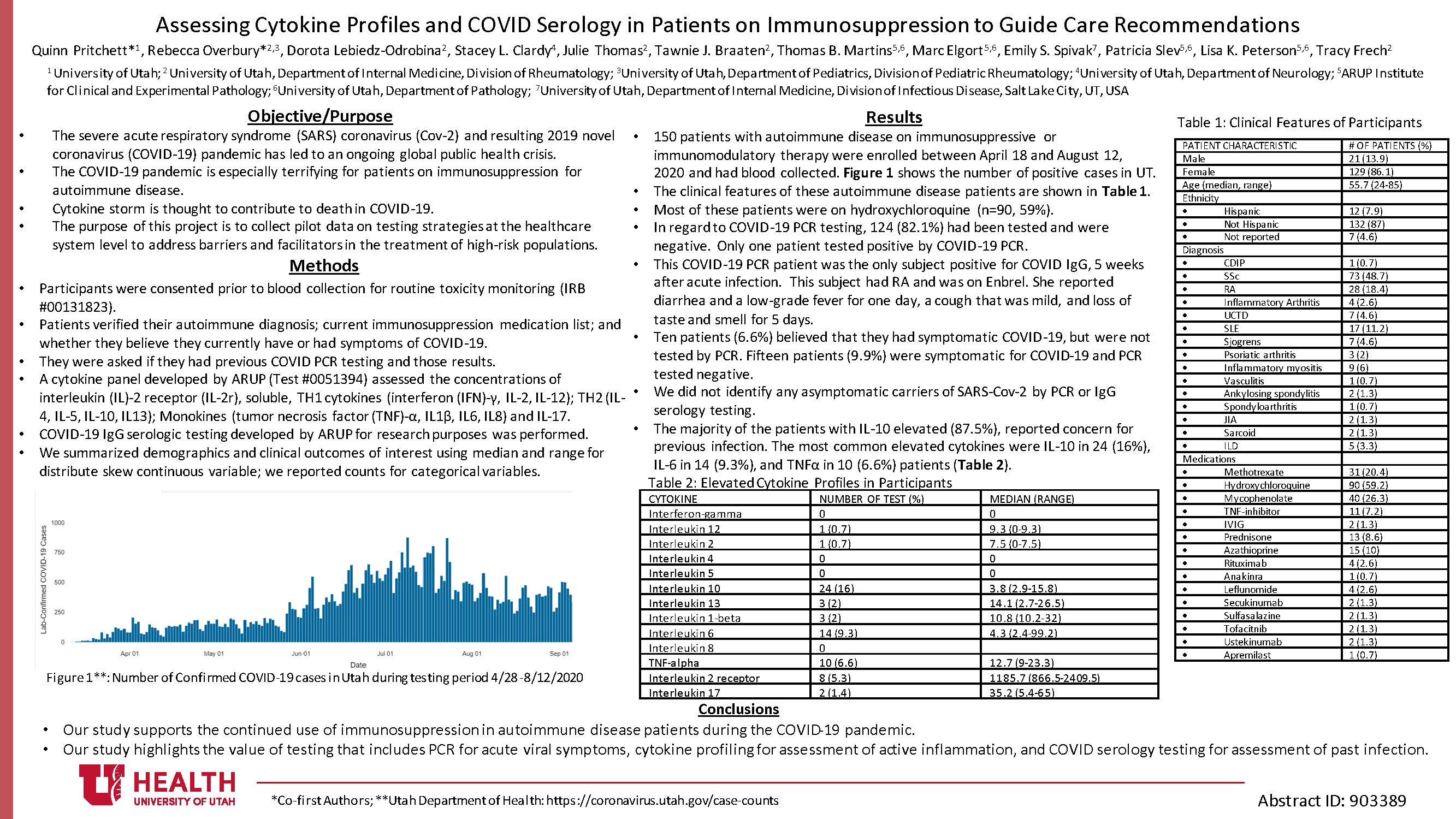
Tejinder Singh, MDS,MPH -
Buddhist Monks as Community Organizers: An Indigenous Response to COVID-19 in the Spiti Valley of Northern India
- Peter de Schweinitz, MD,MPH 2. Ishita Khanna,MA 3.Norbu Vaidya
Many large nations have failed to adequately protect their indigenous populations from COVID-19, a novel disease that has challenged overarching nation-states to develop plans that are politically acceptable to and effective for heterogeneous populations.1 2 These failures of the nation state to adequately protect citizens have endangered indigenous communities but also opened a space for indigenous solidarity, organization, and institution building. The residents of Spiti Valley of Northern India initially attempted to organize against COVID-19 through the secular mechanisms of government in their district. When residents lost trust in their ability to work through official channels, monasteries transcended traditional and contemporary boundaries to cooperate with each other in developing the Committee for Preventive Measures and Sustainable Development (CPMSD). The CPMSD has successfully warded off COVID-19 through a variety of measures, including limiting incoming traffic, quarantine, education, contact tracing, and social distancing. In the process, the Spiti Valley has revitalized traditional structures of governance. Public health practitioners should carefully document how indigenous (and other) communities organize to combat COVID-19. This data—which may reveal practical as opposed to formal networks of authority—may assist current and future public health practitioners to decide how and with whom to invest scarce human resources.

Shivakumar R. Veerabhadraiah -
Lung Epithelial Cell Susceptibility Driven by Surfactant Protein-C Mutation Enhances Ozone Induced Toxicity
Jacklyn P. Nguyen, Brittnie S. Armstrong, Alessandro Venosa
Ozone is a ubiquitous air pollutant that causes moderate parenchymal stress and monocyte/macrophage inflammation in healthy individuals. These effects are heightened in susceptible populations including the elderly and patients affected by interstitial lung disease (i.e., pulmonary fibrosis, PF). Pulmonary fibrosis is a degenerating disease characterized by progressive disruption of the alveolar architecture interspersed with episodes of acute inflammatory exacerbations. Mutations in the alveolar epithelial type-2 cell-specific Surfactant Protein C (SP-C) gene (SFTPC) have been identified in a subset of PF patients, with the Ile->Thr substitution at position 73 (SP-CI73T) as the most prevalent. To investigate the susceptibility of SP-C mutant populations to acute ozone exposure, we leveraged a novel inducible SP-CI73T transgenic mouse. Low-level SP-CI73T expression produces moderate enlargement of the alveolar septae, AT2 cell hyperplasia, and minor inflammation beginning at 16wk and deteriorating with time. Conversely, SP-CI73T induction results in extensive polycellular inflammation, decline in respiratory function and lung remodeling, distinctive features of acute exacerbations. Population RNA-sequencing and targeted cytokine analysis of bronchoalveolar lavage fluid show that AT2 cells initiate monocyte/macrophage recruitment and activation via canonical (Ccl2, Cx3cr1) and non-canonical (Il5, Ccl11, and Ccl17) pathways during SP-CI73T acute exacerbations. Consistent with these findings, RNA-sequencing of SiglecFloCD11b+CD64-Ly6C+ monocytes indicate highly inflammatory (Nos2, Il-6) and pro-fibrotic (Col1a1, Col1a2) phenotype. Pharmacologic (intravascular clodronate liposomes) and genetic (Ccr2 knockout mice) monocyte ablation resulted in reduced inflammatory burden and improved survival following SP-CI73T exacerbations. Acute low-dose ozone exposure (0.8ppm, 3h) of SP-CI73T mice resulted in heightened alveolar septal disruption, edema and perivascular immune cell infiltrate compared to SP-CWT cohorts. These responses were observed in mice undergoing acute exacerbations, as well as aged SP-CI73T cohorts (52 wk) expressing low levels of mutant protein. Taken together, our findings highlight intimate crosstalk between epithelial and inflammatory monocytes during acute exacerbations. In addition, these data support the notion that epithelial dysfunction aggravates respiratory symptoms induced by ozone exposure.
